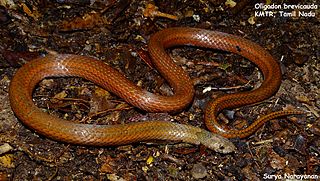
Tiger snakes are a large and highly venomous snake of southern Australia, including its coastal islands and Tasmania. These snakes are often observed and locally well known by their banding, black and yellow like a tiger, although the species can be highly variable in coloration and patterning. All populations are classified within the genus Notechis (Elapidae). Their diverse characteristics have been classified either as distinct species or by subspecies and regional variation.

Oligodon is genus of colubrid snakes that was first described by the Austrian zoologist Fitzinger in 1826. This genus is widespread throughout central and tropical Asia. The snakes of this genus are commonly known as kukri snakes..
The Assam keelback, commonly known as Peal's keelback, is a species of snake in the subfamily Natricinae of the family Colubridae. The species is endemic to Northeast India. It has recently been rediscovered after 129 years in Arunachal Pradesh.

The arani kukri snake, is a species of nonvenomous colubrid found mainly in South Asia.

Oligodon cinereus, the ashy kukri snake, ashy kukri snake, black cross-barred kukri snake, golden kukri snake, or Günther's kukri snake, is a species of snake in the family Colubridae.

Oligodon brevicauda, the shorthead kukri snake, is a species of snake found in the Western Ghats of India.
Oligodon woodmasoni is a species of snake in the family Colubridae. The species is endemic to the Nicobar Islands of India.

The western kukri is a rear-fanged species of snake found mainly on the forest floor in the Western Ghats mountain range of India, usually south of the Goa Gap, a pass in the mountain range. The snakes are brown above with a dark brownish patch on the head that appears like a bird silhouette on the head. The underside is patterned in yellow and black.
Hydrophis mamillaris, sometimes referred to as the Bombay sea snake or broad-banded sea snake is a species of venomous sea snake native to the Indian Ocean. It is a poorly studied and surveyed species, with few records and a dubious type specimen.
Oligodon nagao is a species of snakes in the family Colubridae. Specimens have been collected from Lang Son and Cao Bang in northern Vietnam, Guangxi Autonomous Region in southern People's Republic of China, and from Khammouane Province in central Laos PDR.

Oligodon kheriensis, also known as the coral kukri snake or red coral kukri snake, is a Kukri snake that was first described in 1936 from the North Kheri Division in Uttar Pradesh, India.

Chrysopelea taprobanica, the Sri Lankan flying snake or Indian flying snake, is a species of gliding snake distributed in India and Sri Lanka. It can glide, as with all species of its genus Chrysopelea, by stretching the body into a flattened strip using its ribs. The snake is known as "dangara dandaa - දඟරදන්ඩා" in Sinhala, due to its folding postures.
Oligodon calamarius, commonly known as the reed-like kukri or Templeton's kukri snake, is a species of nonvenomous colubrid endemic to Sri Lanka. It is known as කබර දත්-කැටියා in Sinhala.
Oligodon moricei, commonly known as Morice's kukri snake, is a species of snake in the family Colubridae. The species is endemic to southern Vietnam.
Oligodon pseudotaeniatus, commonly known as the false striped kukri snake, is a species of colubrid snake. It is endemic to Thailand and known from the Nakhon Ratchasima Province, Saraburi Province, and Bangkok. The type series was collected by Malcolm Arthur Smith. The specific name pseudotaeniatus refers to its similarity to Oligodon taeniatus, with whom it was confused prior to its species description in 2008.
Oligodon annamensis, commonly known as the Annam kukri snake, is a species of colubrid snake originally known from two specimens from Vietnam, where it was thought to be endemic. It has also since been found in Cambodia and Thailand.

Wallaceophis is a genus of snake in the family Colubriadae. It was first described in 2016. The sole species is Wallaceophis gujaratensis which is found in the Indian state of Gujarat. Wallaceophis gujaratenisis is presently known from just seven localities of Gujarat and virtually nothing is known about its biology. Common names Wallace's striped snake and Wallace's racer has been suggested for it.

Oligodon huahin is a species of kukri snakes in the genus Oligodon. The species was first discovered and described in late 2016, and the article was published July 13, 2017. It is only known from its type locality but its range is likely to be more extensive. O. huahin is thought to be very secretive, similar to other species of the genus Oligodon. This theory is supported by the type specimen, which all were males, suggesting that it was found during the mating season where males are out and actively search for females to reproduce. This may also explain why this species had not yet been discovered

Trimeresurus salazar, also known as Salazar's pit viper, is a species of venomous, green pit viper first discovered in 2019 in the lowlands of the western part of Arunachal Pradesh, India; the fifth new reptile species to be discovered in the region in 2019. It was named after Salazar Slytherin from the Harry Potter series. It has a dark green head and yellowish green dorsal scales on the rest of its body. The species is sexually dichromatic; the males have reddish-orange and yellow-orange stripes and a rusty red-orange tail that the females lack. Its habitat is under threat from human development activities.











